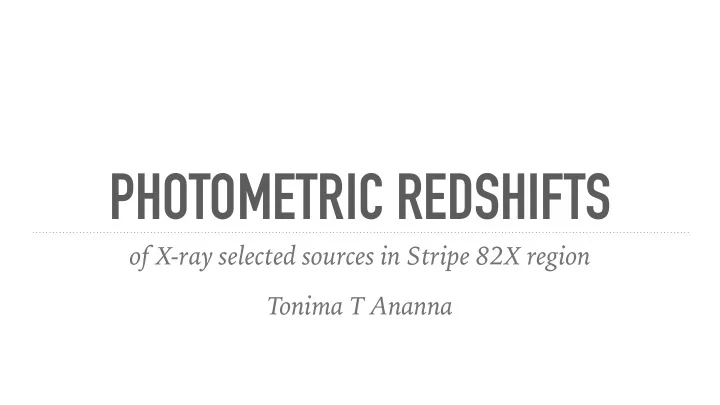

PHOTOMETRIC REDSHIFTS of X-ray selected sources in Stripe 82X region Tonima T Ananna
WHY STRIPE 82? 300 sq deg observed between 80 to 120 ➤ times by SDSS Also by UKIDSS, GALEX, VISTA, 2MASS ➤ and WISE 31.3 sq deg observed by Archival Chandra, ➤ Archival XMM, XMM AO10 and AO13 - ideal for assigning discrete sources to Xray photons (Lamassa et al 2015)
EACH FIELD AND NUMBER OF SOURCES IN EACH ARCH ARCH AO13 AO10 XMM Chandra FIELD (LAMASSA ET AL 2015 FIGURE 1): 15.6 4.6 6 7.4 Area deg sq deg sq deg sq deg sq 4.56 17-65 5.7-71.2 Expos. 6-8 Ks Time Ks Ks Ks 2440/ 635/ 1438/ 785/ # of sources 1820 410 881 463 548/ 167/ 107/ # with 89/84 z-spec 526 153 101
COLLECTION OF PHOTOMETRY ➤ Coadded SDSS catalog (Jiang et al 2014) reaches 1.9-2.2 magnitudes deeper ➤ Simple aperture corrected photometry using Lamassa et al SDSS coordinates ➤ ALLWISE - better astrometry and photometric sensitivity than ALLSKY - took point source photometry within 1” ➤ GALEX - SEXTRACTOR aperture photometry within 2” ➤ VISTA and UKIDSS match within 2.0” - aperture sizes 2.8” and 5.7” - not using 2mass right now
SETTING UP LEPHARE ➤ Filter response curves ➤ Redshifts to try - goes unto 6 in steps of 0.04 ➤ Error weight for each band: 0.2, 0.3 for Galex and Wise, 0.02-0.05 for rest ➤ Absolute magnitude ranges to try: -24 to -8 for nearby sources and -30 to -20 for QSOs ➤ Some other priors such as fraction of reddening to try on SED libraries
CALCULATING SYSTEMATIC SHIFTS ➤ Chose 500 objects marked regular galaxies from SDSS stripe 82 region ➤ Matched within 1” with all other catalogs ➤ Ended up with 278 final sources with no AGN component ➤ Used to calculate systematic shifts for extended objects ➤ For point sources - chose regular stars, but Lephare cannot automatically calculate these systematic shifts for nearby stars, so…
CLASSIFYING OBJECTS ➤ Variability information from PSF prob ==1 and personal communications with variability > 0.5? Dr. Christophe Yèche and Dr. Nathalie Palanque-Delabrouille No Yes EXTNV QSOVs EXTNV Bright EXTNV Faint (soft flux >= 8E-15) (soft flux < 8E-15)
Salvato et al 2011
EXTNV BRIGHT EXTNV FAINT
ALAS!
GALMS MAG ABS -24,-8: EXTNV bright
HOW TO SOLVE THE CLASSIFICATION PROBLEM? ➤ SDSS psf prob not reliable enough, we are using FWHM from Jiang et al catalog ➤ But we also found that there were variable extended sources ➤ We finally decided to categorize as follows: ➤ EXTNV: variability < 0.5, FWHM in i band > 1” ➤ EXTVAR: variability > 0.5 and FWHM in i band > 1” and point like for all sources with FWHM < 1”
E X T N V
P O I N T L I K E
SLIGHT SYSTEMATIC ISSUE WITH AO13 PS… ➤ Simm et al 2015 showed that for variable sources, single epoch photometry improves median results for variable sources rather than coadded, so we took outliers from PS AO13:
E X T V A R
AO13 CHANDRA
FUTURE PLANS ➤ We still need to work on classifying EXTVAR properly and having the right library for these sources. Some EXTVAR work better with single epoch photometry, but not all. Explore how to isolate… ➤ Check reliability of counterparts for Archival XMM and Chandra ➤ Any ideas you may have for improvements…
MANY THANKS TO: Dr. Mara Salvato Dr. Stephanie Lamassa Professor Meg Urry
Recommend
More recommend